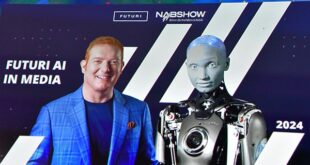And speaking of the NBA, even if I don’t give a damn about it right now, it is to be commended for being open to technological innovation and willingness to try new things:
- The NBA itself is stocked with tech-savvy moguls – Microsoft Corp. co-founder Paul Allen owns the Portland Trail Blazers; Internet broadcasting pioneer Mark Cuban used some of his dot-com windfall to buy the Dallas Mavericks. And the Philadelphia 76ers belong to Comcast Corp., the cable TV giant run by Brian L. Roberts that is trying to buy Walt Disney Co.
Perhaps that’s why the NBA has raced ahead of other professional leagues in embracing new technology to promote its sport. The NBA was the first to broadcast live video of a professional sports match-up over the Internet, and the first to deploy a 360-degree camera to capture the action. The league was also the first to let viewers control the camera on an Internet video feed. Fans can tune into NBA.com to listen to many games live and watch highlight videos.
Innovations like these are changing the economics of the game, and [NBA Commissioner David] Stern spoke with The Times last week about what else may be in store.
Question: Pro basketball games are widely available on the radio and on TV. Why did you decide to broadcast them over the Internet?
Answer: This is just another step in our evolution. We have been doggedly determined to put our games in front of our fans wherever we find them and however they can access them. This is just a whole other way to reach our subscribers, our fans, our consumers. It’s just a step, not an end unto itself.
Q: You’ve done some experiments with video on the Internet. What have they told you so far?
A: That if we stream a game in Mandarin, lots of Chinese viewers will tune into it.
The preferred methodology is still TV. If we have a game that is not available in any other modality, then people will watch grainy video [over the Internet]. It’s hit and miss. We’re willing to try it.
Q: How do your TV broadcasting partners see your activities on the Internet?
A: They see it as completely supportive. Each of our TV partners promotes the other. Now we promote ESPN, TNT, ABC. It’s a circle. There’s not really a choice here: You either move along the promotional road, or you wither.
….Q: What about other new technologies for TV?
A: I think one of the great, great boons to televised sports is going to be the widespread adoption of wide-screen television and Dolby surround sound. The better the courtside seat in a sport, the better the high-def experience. I’m partial, but we have the best courtside seat in all of sports. It’s close and it’s unadorned by sleeves and long pants.
Q: As the Internet business models get hammered out, what do you think will remain free and what will be paid for?
A: It’s the razors and blades theory. Some people will be giving away the razors to sell the blades. Someone will say, “You can have video-on-demand to your heart’s content, you can see high-definition to your heart’s content. Oh, by the way, you’ve got to become a digital subscriber and let us put a box in for X dollars a month.” Is it free? Did we charge for it?
It’s all going to be paid for in some way, but some of it’s going to be called free.
….Q: And where will those changes take us?
A: I don’t think that anyone could know. But the analogy I use is that in the “days of old,” you could wait at the corner for the light to change. And now there’s just no lights. You’ve got to just start moving across the roadway, because if you don’t you’ll be locked at the corner. [LA Times]
Excellent point: try it all and see what sticks. The down side of this attitude is the possibility of being perceived as gimmicky, but better gimmicky than finding yourself in the position of the RIAA: doing all you can to dig in your heels and prevent innovation. Remember, it’s all entertainment.
 Blogcritics The critical lens on today's culture & entertainment
Blogcritics The critical lens on today's culture & entertainment



